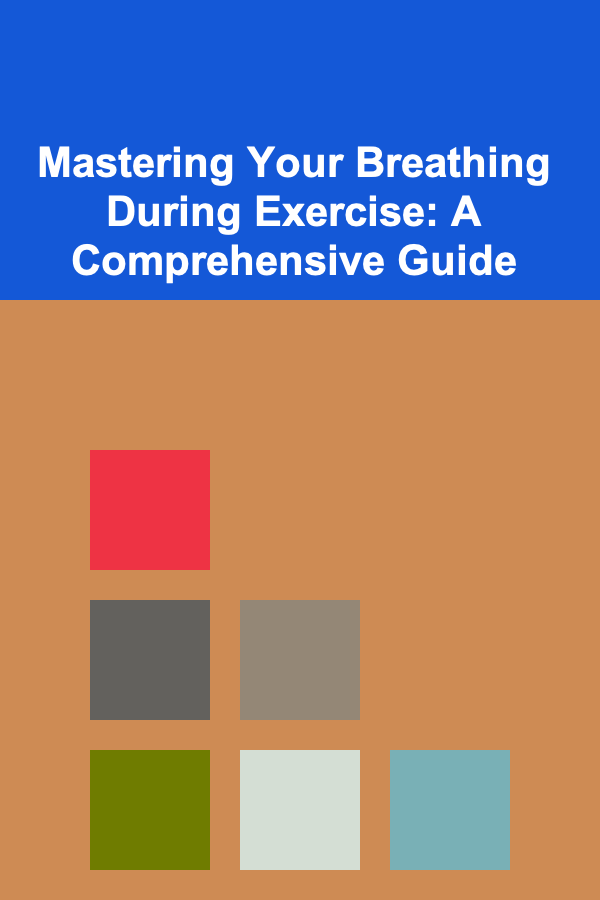
Mastering Your Breathing During Exercise: A Comprehensive Guide
ebook include PDF & Audio bundle (Micro Guide)
$12.99$7.99
Limited Time Offer! Order within the next:

Breathing, an involuntary act essential for life, often becomes an afterthought during exercise. However, consciously controlling and optimizing your breathing can significantly enhance your performance, improve endurance, reduce fatigue, and even minimize the risk of injury. This comprehensive guide explores the intricacies of breathing during exercise, delving into the physiological mechanisms, different breathing techniques, common mistakes to avoid, and strategies for incorporating mindful breathing into your fitness routine.
The Physiology of Breathing During Exercise
To effectively master your breathing during exercise, it's crucial to understand the underlying physiological processes. Breathing serves the vital function of supplying oxygen to the working muscles and removing carbon dioxide, a waste product of cellular respiration. During exercise, the body's demand for oxygen increases dramatically, leading to an accelerated breathing rate and deeper breaths.
Oxygen Delivery and Carbon Dioxide Removal
The lungs are the primary organs responsible for gas exchange. When you inhale, oxygen-rich air enters the lungs and diffuses into the bloodstream, where it binds to hemoglobin in red blood cells. This oxygenated blood is then transported to the muscles, where it's used to generate energy through cellular respiration. As a byproduct of this process, carbon dioxide is produced and transported back to the lungs via the bloodstream. When you exhale, carbon dioxide is expelled from the body.
During exercise, the increased metabolic rate requires a greater supply of oxygen and a more efficient removal of carbon dioxide. The body responds by increasing both the breathing rate (number of breaths per minute) and the tidal volume (amount of air inhaled or exhaled with each breath). This increased ventilation ensures that the muscles receive the oxygen they need and that carbon dioxide doesn't accumulate to toxic levels.
The Role of the Respiratory Muscles
Breathing involves the coordinated action of several respiratory muscles, including:
- Diaphragm: The primary muscle of respiration, the diaphragm is a large, dome-shaped muscle located at the base of the chest cavity. When the diaphragm contracts, it flattens, increasing the volume of the chest cavity and drawing air into the lungs.
- Intercostal Muscles: Located between the ribs, the intercostal muscles help to expand and contract the chest cavity during breathing. The external intercostals assist with inhalation, while the internal intercostals assist with exhalation.
- Accessory Muscles: During strenuous exercise, accessory muscles such as the sternocleidomastoid and scalene muscles in the neck, and the pectoralis muscles in the chest, may also be recruited to assist with breathing.
Efficient breathing relies on the coordinated and efficient functioning of these respiratory muscles. Strengthening these muscles through specific exercises can improve breathing capacity and reduce respiratory fatigue during exercise.
The Impact of Exercise Intensity on Breathing
The intensity of exercise directly affects breathing patterns. As exercise intensity increases, so does the demand for oxygen and the need to eliminate carbon dioxide. This leads to predictable changes in breathing rate and depth.
- Low-Intensity Exercise: During activities like walking or light jogging, breathing is typically slow and shallow, primarily relying on diaphragmatic breathing.
- Moderate-Intensity Exercise: As exercise intensity increases, breathing becomes faster and deeper, engaging both the diaphragm and the intercostal muscles.
- High-Intensity Exercise: During activities like sprinting or heavy weightlifting, breathing becomes rapid and deep, often requiring the recruitment of accessory muscles. Breath-holding may also occur briefly during maximal exertion.
Understanding how exercise intensity affects breathing allows you to adjust your breathing technique accordingly to optimize performance and minimize discomfort.
Breathing Techniques for Different Types of Exercise
Different types of exercise require different breathing techniques to maximize efficiency and minimize strain. Here's a breakdown of effective breathing strategies for various activities:
Diaphragmatic Breathing (Belly Breathing)
Diaphragmatic breathing, also known as belly breathing, involves using the diaphragm as the primary muscle of respiration. This technique promotes full lung expansion, improves oxygen intake, and can help to reduce stress and anxiety.
How to practice diaphragmatic breathing:
- Lie on your back with your knees bent and feet flat on the floor.
- Place one hand on your chest and the other on your abdomen.
- Inhale slowly through your nose, allowing your abdomen to rise while keeping your chest relatively still.
- Exhale slowly through your mouth, allowing your abdomen to fall.
- Repeat for several minutes, focusing on the movement of your abdomen.
Diaphragmatic breathing is particularly beneficial for low-intensity activities like walking, yoga, and Pilates.
Chest Breathing (Thoracic Breathing)
Chest breathing, also known as thoracic breathing, involves primarily using the intercostal muscles to expand and contract the chest cavity. While chest breathing can be efficient for certain activities, it tends to be shallower than diaphragmatic breathing and may lead to hyperventilation if overused.
How to practice chest breathing:
- Sit or stand upright with your shoulders relaxed.
- Place your hands on your ribs.
- Inhale deeply through your nose, expanding your chest while keeping your abdomen relatively still.
- Exhale slowly through your mouth, allowing your chest to contract.
- Repeat for several minutes, focusing on the movement of your chest.
Chest breathing may be useful for activities that require quick bursts of energy, such as sprinting or interval training.
Rhythmic Breathing
Rhythmic breathing involves coordinating your breathing with your movements during exercise. This technique can help to improve efficiency, reduce fatigue, and maintain a steady pace.
How to practice rhythmic breathing:
- Choose a rhythmic activity, such as running or swimming.
- Coordinate your breathing with your footfalls or strokes. For example, inhale for three steps and exhale for two steps while running.
- Adjust the breathing pattern to match the intensity of the exercise.
- Focus on maintaining a steady and controlled breathing rhythm.
Rhythmic breathing is particularly effective for endurance activities like running, swimming, and cycling.
Box Breathing
Box breathing is a simple yet powerful technique that involves inhaling, holding your breath, exhaling, and holding your breath again, each for the same amount of time. This technique can help to calm the nervous system, reduce stress, and improve focus.
How to practice box breathing:
- Find a comfortable position, either sitting or lying down.
- Inhale slowly through your nose for four seconds.
- Hold your breath for four seconds.
- Exhale slowly through your mouth for four seconds.
- Hold your breath for four seconds.
- Repeat for several minutes, focusing on the rhythm of your breathing.
Box breathing can be used before, during, or after exercise to manage stress and improve focus.
Power Breathing (For Weightlifting)
Power breathing, also known as the Valsalva maneuver, involves holding your breath during the most strenuous part of a lift. This technique can help to stabilize the spine and generate more power, but it should be used cautiously and only for short periods of time, as it can temporarily increase blood pressure.
How to practice power breathing (with caution):
- Inhale deeply before starting the lift.
- Hold your breath tightly as you perform the most difficult part of the lift.
- Exhale forcefully as you complete the lift.
- Do not hold your breath for extended periods. This is for very short bursts of power.
- This technique is generally only recommended for experienced weightlifters who are familiar with proper form.
It's essential to consult with a qualified fitness professional before using power breathing techniques, especially if you have any underlying health conditions.
Common Breathing Mistakes During Exercise
Avoiding common breathing mistakes is crucial for maximizing performance and minimizing the risk of injury. Here are some common errors to be aware of:
- Holding Your Breath: Holding your breath, especially during weightlifting or high-intensity exercise, can lead to a dangerous increase in blood pressure and may increase the risk of fainting. Always exhale during the most strenuous part of an exercise.
- Shallow Breathing: Shallow breathing limits oxygen intake and can lead to fatigue and dizziness. Focus on taking deep, full breaths that engage the diaphragm.
- Mouth Breathing: While mouth breathing may be necessary during intense exercise, excessive mouth breathing can lead to dry mouth and may increase the risk of respiratory infections. Try to breathe through your nose as much as possible.
- Hyperventilation: Hyperventilation, or over-breathing, can lead to dizziness, tingling sensations, and anxiety. Focus on slowing down your breathing rate and taking deeper breaths.
- Ignoring Breathing Cues: Pay attention to your body's breathing cues. If you feel short of breath or lightheaded, slow down and focus on regaining control of your breathing.
- Not Exhaling Completely: A full exhale allows for a fuller inhale. Many people only partially exhale, which limits the amount of fresh oxygen they can bring into their lungs.
Being mindful of these common mistakes can help you to optimize your breathing technique and improve your overall exercise experience.
Strategies for Incorporating Mindful Breathing into Your Fitness Routine
Making conscious breathing a habit requires practice and integration into your fitness routine. Here are some strategies for incorporating mindful breathing into your workouts:
- Warm-Up: Start each workout with a few minutes of diaphragmatic breathing to prepare your respiratory system and calm your mind.
- Focus on Breathing Rhythm: During your workout, pay attention to your breathing rhythm and coordinate it with your movements.
- Use Breathing Cues: Use specific breathing cues, such as "inhale on the way down, exhale on the way up," to help you maintain a consistent breathing pattern.
- Monitor Your Breathing: Regularly check in with your breathing throughout your workout. Are you breathing deeply and efficiently? Are you holding your breath?
- Cool-Down: End each workout with a few minutes of box breathing or diaphragmatic breathing to promote relaxation and recovery.
- Practice Daily: Dedicate a few minutes each day to practicing mindful breathing techniques, even when you're not exercising.
- Use Apps and Guided Meditations: There are many apps and guided meditations available that can help you to improve your breathing technique and cultivate mindfulness.
- Record your progress: Keep a journal or use a fitness tracker to monitor your breathing rate and other relevant metrics during exercise. Note any improvements or challenges you encounter.
- Seek Professional Guidance: Consider working with a respiratory therapist, yoga instructor, or other qualified professional who can provide personalized guidance on breathing techniques.
By consistently practicing mindful breathing techniques, you can transform your breathing from an unconscious act into a powerful tool for enhancing your fitness performance and overall well-being.
Breathing Considerations for Specific Conditions
Individuals with certain medical conditions need to pay particular attention to their breathing during exercise. These include:
- Asthma: Individuals with asthma should use their inhaler before exercise and be aware of potential triggers, such as cold air or allergens. They should also focus on diaphragmatic breathing to improve lung capacity.
- COPD: Individuals with COPD should work with their doctor to develop a safe and effective exercise plan that includes breathing exercises. They may benefit from pursed-lip breathing to help control shortness of breath.
- Anxiety: Individuals with anxiety may experience hyperventilation during exercise. They should practice relaxation techniques, such as box breathing, to manage anxiety and control their breathing.
- Heart Conditions: Individuals with heart conditions should consult with their doctor before starting any new exercise program. They should avoid holding their breath and focus on maintaining a steady breathing rhythm.
- Pregnancy: Pregnant women should consult with their doctor before engaging in exercise. They should avoid exercises that involve holding their breath or straining the abdominal muscles. Diaphragmatic breathing can be particularly beneficial during pregnancy.
It's essential to consult with a healthcare professional to determine the best breathing strategies for your individual needs and health conditions.
Conclusion
Mastering your breathing during exercise is a journey that requires awareness, practice, and patience. By understanding the physiology of breathing, learning different breathing techniques, avoiding common mistakes, and incorporating mindful breathing into your routine, you can unlock your full fitness potential and enjoy a more fulfilling and injury-free exercise experience. Remember that breathing is a skill that can be developed and refined over time. Embrace the process, be patient with yourself, and enjoy the benefits of improved breathing during exercise.

How to Score Big Deals: Bargain Hunting for Furniture and Home Decor
Read More
How to Sell Collectible Vinyl Records on Online Marketplaces: A Comprehensive Guide
Read More
Turning Deep Learning Knowledge into a Profitable Side Hustle
Read More
Unlocking Success as a Civil Engineer: A Comprehensive Guide to Engineering Projects and Problem Solving
Read More
How To Master the Neuroscience of Personal Transformation
Read More
Supporting Children with Special Needs in Early Ed: A Comprehensive Guide
Read MoreOther Products

How to Score Big Deals: Bargain Hunting for Furniture and Home Decor
Read More
How to Sell Collectible Vinyl Records on Online Marketplaces: A Comprehensive Guide
Read More
Turning Deep Learning Knowledge into a Profitable Side Hustle
Read More
Unlocking Success as a Civil Engineer: A Comprehensive Guide to Engineering Projects and Problem Solving
Read More
How To Master the Neuroscience of Personal Transformation
Read More